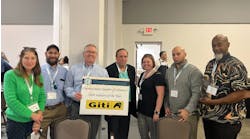Cooper Tire & Rubber Co. today reported a net loss of $55 million for the quarter ended Sept. 30, 2008. However, net sales for the period were a record $794 million, an increase of $26 million, or 3.4%, from the prior year.
The increased revenues were driven by pricing and improved mix partially offset by decreased tire unit volumes in the United States, the company says.
Results were pressured by unprecedented raw material cost increases, higher utility costs, and production curtailments due to raw material shortages caused by hurricanes in the Gulf Coast region, reports the company.
Quarterly earnings were also negatively impacted by an accounting rule that prohibits recognition of potential future tax benefits of certain losses. This prohibition does not affect the company’s ability to use those losses against future profits of the company.
Through the first nine months of 2008, Cooper generated a record $2.2 billion in net sales. Net losses were $76 million during the same period, compared with net income of $53 million from continuing operations in 2007.
North American Tire operations
North American Tire operations generated sales of $586 million, up 2% from 2007’s record third quarter. Operating losses were $51 million, a decrease of $78 million from the same period in 2007.
Sales were affected by softening demand in North America as consumers reacted to the credit crisis and increased gas prices, says Cooper. The most significant volume decreases were in the broadline and light truck product segments.
The Cooper brand continued to increase its market share in the U.S. compared to the Rubber Manufacturer Associations reported shipments. It also had success in expanding its market presence in Mexico and Canada.
Operating profit for North American Tire declined year over year as a result of several key factors. Raw material increases during the quarter negatively affected results by $104 million compared to the prior year quarter. This was partially offset by price and mix increases of $41 million.
Volume decreases affected profits by $13 million. The curtailment of production resulted in unabsorbed fixed overhead during the period of $9 million.
Manufacturing operations improved by $6 million, despite increased utility costs, as a result of the company’s continued focus on improvement in this area. Other significant factors impacting results for the segment were decreased products liability expense for the quarter of $8 million, and lower incentive related costs. The third quarter of 2007 included a $14 million dollar last-in, first-out inventory benefit, which did not repeat in 2008.
Factors in global commodity markets are driving record-high raw material prices, specifically, in natural and synthetic rubber as well as other petroleum-based materials, the company reports. These high prices, coupled with the use of LIFO cost flow assumptions for inventory accounting in North America, have contributed to decreased earnings.
Cooper Tire also invested in a manufacturing facility in Mexico during the quarter. This is another step in the company’s strategic plan to establish a more sustainable and cost competitive manufacturing footprint, says the company. It is receiving tires from the facility and is actively increasing production at the facility while implementing efficiency improvements.
International tire operations
The Company's international tire operations reported record sales of $285 million in the quarter, an increase of 21% compared with the third quarter of 2007. This increase was the result of improved price and mix, and the continued successful ramp up of the company’s Cooper Kenda Tire JV in China.
This facility achieved a production milestone of 10,000 tires per day during the quarter, ahead of schedule, Cooper Tire reports. The company continued to implement price increases along with cost savings measures across its international operations in an effort to offset increased raw material costs.
The segment’s results were also negatively impacted by the effects of the Olympics that took place in Beijing and resulted in decreased economic activity and production curtailments in China during the quarter.
Despite these increasing raw materials costs, inflationary pressures and the start-up costs related to developing a larger presence in Asia, the segment delivered operating profit of $7 million.
Management commentary and outlook
After the quarter ended, the company announced it is executing a network capacity study of its U.S. facilities that is likely to result in restructuring, including capacity consolidation or geographical shifts to production.
Roy Armes, CEO, commented, “Our business has come under intense pressure from several fronts including increased raw material costs, decreased global demand, and more intense competition. We are committed to reaching the long-term goals we established in our Strategic Plan and are proactively taking steps to achieve those goals.
"The pillars of our plan include establishing a sustainable and cost competitive supply of tires, profitably growing our business, and enhancing our organizational capabilities to continue providing excellent value and service to our customers. We believe it is prudent to increase our level of caution in executing our plan. Therefore, we have significantly reduced our capital expenditures. The capacity study is aligned with improving our cost competitive position in the United States. Our investment in Mexico supports our efforts to secure a lower cost supply of high quality tires.
“Our international operations continue to focus on improving costs and aligning with market needs. The focused approach we are applying has allowed the segment to maintain success in a difficult environment. We are cautious in our outlook for this segment, for the remainder of the year, due to global demand weakening.
“We also have continued to implement automation projects, deploy resources to implement Six Sigma and Lean, and develop new products that meet our customers’ needs. While the near-term outlook is pressured by macroeconomic events around the globe, we believe the actions we are taking are appropriate. We have not had to draw down on our existing credit lines and maintain cash reserves to support our plans. We believe Cooper will emerge from the current scenario a stronger competitor able to profitably take advantage of opportunities.”


